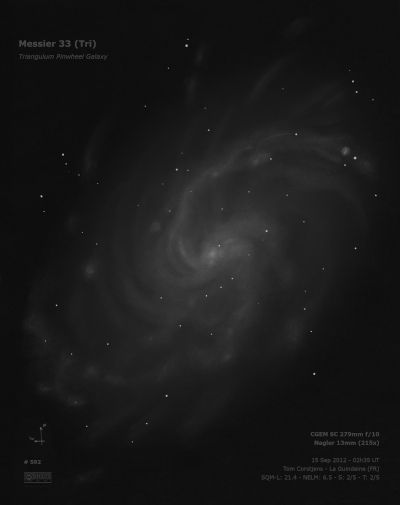Triangulum Galaxy,Triangulum Pinwheel
Triangulum Galaxy,Triangulum Pinwheel

Gioivanni Hodierna probably discovered M33 = NGC 598 = H V-17 = h131 before 1654 and catalogued it as a cloud-like nebulosity or obscuration "near the Triangle". Charles Messier independently discovered M33 on 25 Aug 1764. William Herschel assumed it was new (not found at Messier's position) and catalogued it as H. V-17 on 11 Sep 1784 (sweep 266). On 11 Jan 1787 (sweep 680) he noted "The large nebula. The middle of it easily resolvable and some of the stars visible; it is impossible to say how far it may extend; the nebulosity losing itself so gradually, but goes undoubtedly a great way in every direction, but chiefly from sp to nf." A little later in the sweep he noted "Looked for the 33rd of the Conoiss des Temps, but it is not in the place."
John Herschel included only a single observation in the Slough Catalogue from 15 Sep 1828 (sweep 177): "Enormously L; vgbM. The nucl taken; has a * 12m, nf the nucl. The diffused neb extends 15' s[outh] and as much nearly to n[orth]. It has irregularities of light, and even feeble subordinate nuclei [HII knots] and many small stars."
Lord Rosse or assistant George Johnstone Stoney recognized M33 as a spiral on 6 Sep 1849 and his drawing with four or more spiral arms was included in the 1850 PT paper (plate XXXVI, figure 5). The description reads, "New spiral, s(outh) branch the brightest, none F, nf one short but pB, p(receding) on pretty distinct, sf one but suspected; the whole involved in F neby which probably extends past several knots which lie about it in different directions. Faint nebulosity seems to extend very far following." R.J. Mitchell produced a more detailed drawing on 18 Dec 1857 (included in the 1861 publication). Isaac Roberts produced the first excellent photograph of M33 in 1895 with his 20" reflector, revealing more detail than seen visually.
200/250mm - 8" (10/4/80): the bright central region is slightly grain with the halo showing some indication of spiral arms. The edge of the arms were glimpsed with averted vision.
300/350mm - 13.1" (8/23/84): two prominent spiral arms distinctly visible.
400/500mm - 17.5" (11/1/86): bright, very large, elongated 3:2 SSW-NNE, weakly concentrated irregular halo, rises suddenly to a small bright core. Two prominent spiral arms form an "S-pattern" with an irregular surface brightness. At least a dozen HII regions or clusters are resolved (see the numerous IC listings). Overall, the entire galaxy is very mottled and the outer extent is difficult to define.
Naked-eye - (several times): just glimpsed in very dark skies, perhaps visible 25% of the time in best conditions.
Notes by Steve Gottlieb